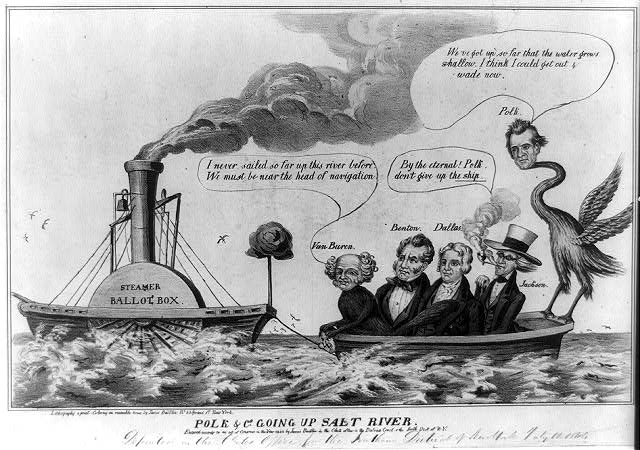We love our letterhead here in the processing sections of the Library of Virginia. One can come across such interesting, varied, and colorful examples while processing Governor’s papers, personal letters, or court records. We’ve shared a few examples of our finds in previous blog postings and have happily learned that you love them, too! As a result, we continue to save examples for future Out of the Box installments. It was with that thought that I made a Xerox of the following letterhead, assuming that I’d add it to our growing file to share at a later date. I showed it to a colleague, and she said, “Google those lines and see what you find.” Sure enough, there was more to this letterhead than met the eye.
The image and line refer to a song written during the 1844 presidential campaign for Whig Party nominee Henry Clay. The illustration shows a raccoon holding a document (or stick) labeled “Constitution,” and rolling a large ball after a scurrying fox. Considered to be the first modern national campaign, the 1844 contest pitted the Whig, Clay, against Democrat James K. Polk. This being Clay’s third presidential race, the Democrats pejoratively dubbed him “the same old coon” in reference to his perennial candidacy. In response, the Whigs decided to embrace the moniker, even using the raccoon image on their banners and bringing live raccoons to rallies. The “Old Kentucky Coon” was born.
This cartoon letterhead, topping what is an otherwise mundane piece of Madison County court paperwork, characterizes the nomination fight amongst the Democrats and uses two lines from a ditty that mocks all of the would-be Democratic candidates. The fox running ahead of the ball pushed by the raccoon is meant to symbolize Martin Van Buren, “the red fox of Kinderhook.” The former president was attempting to gain the Democratic nomination in 1844 alongside Polk, Lewis Cass, Richard M. Johnson, James Buchanan, and John C. Calhoun. The ball represents a popular political advertising gimmick of the day. It became popular for proponents of a particular candidate to roll large leather balls bearing a campaign slogan or candidate’s name through towns as part of a rally or procession in order to garner support for their man. I suppose that’s better than today’s non-stop campaign commercials and robo-calls!
The rally song referenced by the two lines under the illustration was set to the tune of “Old Dan Tucker.” Varied lyrics can be found transcribed online from newspapers but all unfavorably characterized the Democratic candidates challenging Clay. Buchanan was “an old wagon horse,” Johnson, a War of 1812 veteran, was “an old war horse” and slayer of “Tecumsey” [Shawnee chief Tecumseh], and “the fiery Southern horse” referred to Calhoun. These depictions were similar to imagery used in political cartoons of the day.
According to Dr. Michael T. Smith, professor at McNeese State University in Lake Charles, Louisiana, nineteenth-century political cartoons “are often dense with references that [are] sort of hard to puzzle out.” These complex and symbolic illustrations used imagery that would have been familiar to the contemporary American in order to convey certain political or social opinions. One in particular that predicts Democratic defeat shows Van Buren, Polk, Andrew Jackson, Thomas Hart Benton, and George M. Dallas in a dinghy being pulled by the steamer Ballot Box up the Salt River. At the stern of the steamer is a large cabbage on a pike, a reference to imagery from the 1840 campaign indicating the Whigs’ desire to retire Van Buren to Kinderhook “to raise cabbages.” (For more on campaign propaganda from the election of 1840, see the earlier blog post, “This is the House that Jack Built.”) Other cartoons portraying the 1844 presidential candidates that I found while researching this one show Polk as an alligator, Van Buren as a rat, and the incumbent, John Tyler, as a rattlesnake. Still other cartoons address the issue of the annexation of Texas, a major issue of the 1844 campaign.
So, out of a very large (1.5 cubic feet), and mostly dull, court case (Madison County Chancery Cause Administrators of Thomas Shirley vs. Heirs of Thomas Shirley and Zachariah Shirley vs. Administrators of Thomas Shirley, 1919-001) came an interesting piece of scrap paper that took me back to the election of 1844.
-Vince Brooks, Senior Local Records Archivist












Hello, I am a grad student who specializes in Henry Clay and political cartoons, I was wondering how I would go about finding them should I want to use them for my research? Thank you so much, and good finds!
Mr. Wood,
Our online catalog (http://lva1.hosted.exlibrisgroup.com/F), finding aids (http://vaheritage.org/), and digital newspaper collection (http://bit.ly/2qtLFy6) are the most likely sources to consider. You may also wish to consult the Chronicling America digital newspaper project at http://chroniclingamerica.loc.gov/. Best of luck in your research.
Thank you for sharing this! I volunteer for the Somerset Historical Center in Somerset, PA and I came across an extremely similar cartoon in one of our local papers from the 19th Century. The strange this is that these papers dated from the 1870s and 1880s, so any direct connection with Clay would have been lost long ago. Maybe Pennsylvania Republicans were too lazy to adopt their own mascot?
Interesting find, Chris! Curious to see that Clay, perennial candidate and never president, was still a potent symbol 40+ years later.
Thanks for sharing!